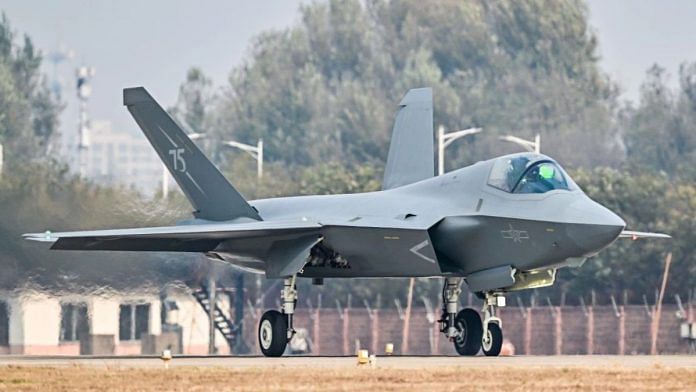China has stunned the world by unveiling two sixth-generation aircraft. Alongside its expanding fleet of fifth-generation J-20 stealth fighters—estimated to exceed 300 and potentially reach 800 by 2030—and the J-35, China’s second fifth-generation stealth aircraft, the latest aircraft pose a significant challenge for India.
Reportedly, Pakistan is set to acquire 40 J-35s, which could give it a technological edge over the Indian Air Force (IAF) and complicate India’s efforts to prepare for a potential two-front conflict.
India urgently needs to develop strategies that help it plug the numerical and technological gap—in effectiveness and cost. While developing fifth and sixth-generation aircraft remains essential, an Anti-Access/Area Denial (A2/AD) strategy offers a pragmatic countermeasure, and could prevent adversaries from controlling airspace.
Why A2/AD is crucial
The IAF currently operates fourth-generation platforms, including the Rafale, Su-30MKI, Mirage-2000, MiG-29, and Tejas Mk-1. However, squadron strength is down to 31 from the sanctioned 42, and will reduce further when MiG-21 and Jaguar fighters are decommissioned. There are delays in inducting Tejas Mk1A fighters due to supply chain reasons and the development of the MkII variant. While these fourth-generation aircraft are capable, they lack the stealth features of China’s J-20 and J-35 and the newly unveiled sixth-generation fighters. India’s indigenous fifth-generation Advanced Medium Combat Aircraft (AMCA) is expected to take at least another decade to enter service.
In the meantime, adopting A2/AD strategies can effectively level the playing field by integrating advanced radars, missile systems, electronic warfare, sensors, unmanned technologies, and space-based surveillance. By employing this strategy, India can address threats without requiring to match its adversary aircraft-for-aircraft.
Also read: Complex network of India’s existing air defence capabilities & the way forward
Key pillars of India’s A2/AD strategy
Multi-layered air defence systems: India must enhance its air defence capabilities with multiple layers. In the short term, this involves deploying additional indigenous Akash missile batteries along with its existing S-400 systems, and expediting the development of the Medium-Range Surface-to-Air Missile (MR-SAM) and Barak 8 ER (extended range) programmes. India must accelerate the development of its indigenous long-range air defence system under Project Kusha, touted to detect and neutralise stealth fighters, drones, and cruise missiles up to 350 km. In the mid-term, India should focus on developing Directed Energy Weapons (DEWs) to intercept aerial threats. Long-term efforts must concentrate on integrating AI-enabled command-and-control systems for automated threat detection and response.
Drone warfare and countermeasures: Drones have revolutionised modern warfare. India must rapidly enhance its drone capabilities, developing loitering munitions, swarm drones that can overwhelm enemy defences, and Unmanned Combat Aerial Vehicles (UCAVs) for precision strikes and loyal wingman. It is crucial to accelerate programmes like Ghatak stealth UCAV and involve India’s private sector for large-scale production. Simultaneously, India must develop effective anti-drone systems, such as lasers and jammers.
Electronic warfare and cyber defence: Future battles will be heavily fought in the electromagnetic spectrum. India should develop advanced jamming systems to disrupt enemy radar and communications, and advanced cyber warfare tools for neutralising adversary satellites and command and control systems. Upgrading fourth-generation fighters with advanced electronic warfare suites and sensors can give them a level of stealth capabilities by detecting, jamming, and deceiving enemy sensors. Integrating survivability-enhancing technologies such as missile warning systems (MAWS), suppression of enemy air defences (SEAD), and expendable decoys is crucial.
Sensor fusion and networked warfare: India must develop systems that integrate data from land, sea, air, and space sensors to get a unified operational picture. Networked systems provide real-time information sharing and help in coordinating responses, enhancing survivability and lethality. By incorporating advanced radars, passive sensors, electronic warfare systems, and decoys in our existing fourth-generation fighters operating in a networked environment, we can achieve a level of stealth that allows them to operate effectively in highly contested environments.
Hypersonic and cruise missiles: Hypersonic missiles can penetrate advanced air defence systems. Fast-tracking programmes like Pralay, Shaurya, and BrahMos-II are critical to delivering high-speed precision strikes. Additionally, it is essential to speed up the development of hypersonic cruise missiles and glide vehicles and extend the range of BrahMos to over 800 km for strikes deep inside enemy territory.
Space-based surveillance and countermeasures: Space assets will be crucial in future conflicts. India should expand its anti-satellite (ASAT) capabilities, as demonstrated in Mission Shakti, while focusing on non-kinetic approaches such as jamming and cyberattacks on enemy satellites. Strengthening satellite surveillance for real-time intelligence gathering will give India a significant information advantage. Furthermore, India should invest in technologies to disrupt adversary satellite navigation systems to hinder adversaries’ ability to target Indian assets.
Infrastructure and resilience: Survivability is key to sustaining operations during conflicts. To maintain operational flexibility, India must build fortified hangars and underground shelters for aircraft, prepare runways for rapid repairs, distributed operations, and deploy mobile launch platforms.
Strategic partnerships: India must leverage its defence ties with the US, France, and Israel to acquire technologies it does not have. These partnerships can bridge gaps in A2/AD capabilities and accelerate technological advancements.
China’s rapid military modernisation is altering the regional power balance to the detriment of India’s security. These developments are an inflection point for India to pivot toward a multi-domain defence strategy. While developing fifth and sixth-generation aircraft will take time, investing in A2/AD technologies will go a long way in countering the threats.
The author is an adjunct scholar at the Takshashila Institution. He tweets @YusufDFI. Views are personal.
(Edited by Prashant)






